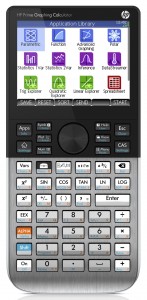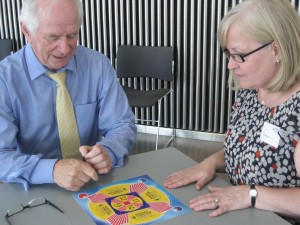 HP Prime will be launched ready for September and the new school year. Have a look at the teaser YouTube HP released to show you what it looks like. Last week I had one in my hands at a launch workshop in Prague led by GT Springer the lead designer. GT has been central to most of the major innovations in graphing calculator design and he has put all of that experience into a genuinely wonderful new device. Read the interview GT gave to the US tech blog Cemetech. First impressions matter to schools who want to show the smart new kit they are buying and to students who want something really flash in an era where new tech does indeed look good. It is interesting that after a stunned response at the NCTM conference in Colorado there has been a lot of buzz around tech sites like Slashgear and Ubergizmo. Well that’s good, because if the tech savvy think it’s worth talking about then bright young teachers and their equally bright students will take a look.
HP Prime will be launched ready for September and the new school year. Have a look at the teaser YouTube HP released to show you what it looks like. Last week I had one in my hands at a launch workshop in Prague led by GT Springer the lead designer. GT has been central to most of the major innovations in graphing calculator design and he has put all of that experience into a genuinely wonderful new device. Read the interview GT gave to the US tech blog Cemetech. First impressions matter to schools who want to show the smart new kit they are buying and to students who want something really flash in an era where new tech does indeed look good. It is interesting that after a stunned response at the NCTM conference in Colorado there has been a lot of buzz around tech sites like Slashgear and Ubergizmo. Well that’s good, because if the tech savvy think it’s worth talking about then bright young teachers and their equally bright students will take a look.
Being an old fogey myself, all I can say is that it looks very smart indeed,with a brushed aluminium front and a smooth bright screen. The colour is bright and very sharp with extremely clear detail and you just have to keep reminding your self that it is a touch screen and that you can drag and move objects and navigate drop down menus. The touch is smooth and very accurate. Younger folk than me will do this instinctively, I’m sure that they will be wondering how it could be done any other way. It is very well made and feels sleek and smooth all round. It is about 300g which feel sufficiently heavy to be solid but easy to hold and it balances really nicely in tho hands with your thumbs over the Home screen and the CAS button. You really feel you are holding a classy piece of kit. So, part one of the battle is won, savvy young people will want one and schools will be proud to show off that they bought them. So, what does it do?
The biggest headline is: wireless connectivity. Files can be transferred via the connectivity software. However, if you plug a small USB dongle (which you purchase seperately) into the top of the PRIME, it will immediately be recognised on the computer, notably the teacher’s computer in class. Files and settings can then be transferred wirelessly. (Only from PRIME to PC not from PRIME to PRIME). More than that, the PRIME screen can be shown on the teacher’s screen. Then their will be class polling functions allowing the teacher to set a question from her computer and students to offer responses from their PRIMES with the results shown in table and chart form. Just like the polling systems many schools are getting which only do this. That will be just the start of what can be done. The critical point is that this a plug-and-play system. No set up, which is a critical factor for classroom use.
The software itself initially looks like an up-rated version of the HP39gII, which it is, so you will find all of the Apps in the HP39gII working exactly the same. So, anyone who has used a HP39gII will get started immediately. However, there are three new Apps which make a big difference. There is a mathematical spreadsheet, a dynamic geometry system and the advanced grapher. Together these represent a major advance in providing an space to explore mathematical ideas. These tie together with the big pause for breath moment. The CAS button.There is no CAS/non-CAS option. A mathematical machine must speak algebra and this one does. There are two home screens; a CAS screen which deals with exact objects and the traditional home screen which deals with approximate objects. The Apps can use the last object from each of these screens and the choice is always there; CAS screen or Home screen. This recognition of the fundamental pure/applied, exact/approximate distinctions is central to an underlying philosophy which has the potential to transform the way we think about exploring mathematics. For me, this is the thing that will determine future research into maths education technology. The spreadsheet, the dynamic geometry and the advanced grapher can all take CAS and non-CAS statements and allow users to explore the results. Just to get a feeling for what this means, have a look at GT’s handouts from the NCTM conference.
Now the sad thing is that exam boards are scared of CAS and we look forward to a future where CAS systems will transform maths exams by getting beyond procedural questions and towards mathematical problem solving. Well done to MEI for getting an A-level module approved allowing CAS and look to Germany and Australia for examples where CAS is embraced. But in the UK CAS is not allowed. Well, no, CAS is not allowed in public maths exams for which any calculator IS allowed. So, it is quite clear that this machine has a CAS system, so could you use it in an exam? To be sure the answer will be yes, the machine includes a comprehensive exam mode. A menu system allows a vast range of features to be turned on or off, CAS is one of the, but suppose a particular exam disallowed solver apps, they can be turned off too. The system is password protected and the user will simply be greeted with a little round exclamation mark if they try to access or disallowed function or suppressed apps will simply be missing from the menu. For school use, the teachers sets the settings they want e.g. turn off the CAS, creates a password and then beams this setting to all of the connected PRIMES, wirelessly. A series of bright LEDS light up in the same sequence while exam mode is engaged. It is immediately clear to the exam secretary that the machine has only those facilities allowed in exams. In discussion with teachers, it became clear that this feature sets up the possibility to allow younger learners to get started with the machine in a simplified mode and actually presented exciting pedagogic possibilities too.
The exams battle is a big one and many schools still think you cannot use any graphing calculator in a maths exam, so we will need to talk with exam boards and the JCQ to make sure the message is clear enough: you can use this machine in a maths exam and without disabling it as an amazing teaching tool.
I’ve always been a fan of calculators as a learning tool. I’ve said elsewhere that tablets are exciting, but you don’t work and think like that, you need different technological tools for different functions and the resilience of the calculator as a form factor is remarkable I think for this reason. It’s a highly portable, personal thinking space. I am really excited about PRIME because it has all of the maths you could possibly want with an intuitive touch driven interface, wireless connectivity to support proper classroom dialogue in a package that everyone will want to own.
Please get in touch with me if you see the video and want to be part of early development to get really exciting maths back into our classrooms. I would be delighted to talk to you about the support I can offer.

